The Ancient Agora
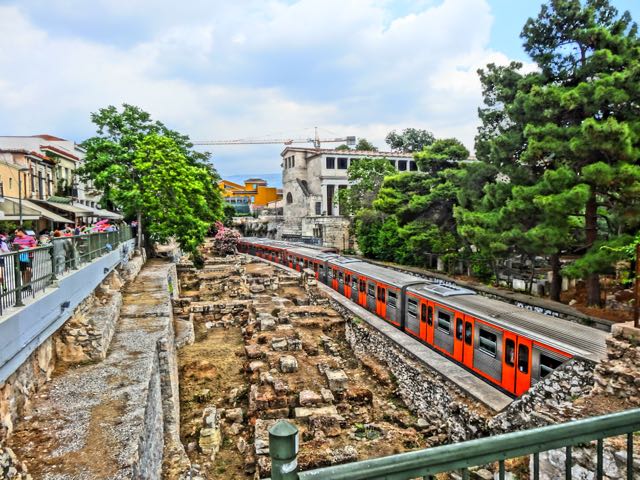 The Ancient Agora of Athens is the largely green area in between Monastiraki and the Acropolis, one of the few archaeological sites in the world that has a train running through it. Agora means marketplace and the scattered piles of rocks and foundational walls are what is left of the
stalls, buildings and
shrines that were the center of life in ancient Athens where Socrates, Pericles, Plato and the rest of those guys once walked, talked and bought fistikia and pasetempo. If you are coming from the Acropolis your entrance ticket used to allow you to visit the Ancient Agora which was great because it is a shortcut to Monastiraki with its shops, restaurants and cafés. But now even though you have to pay don't skip it or be in too much of a rush to get through it
because there are some interesting things you may miss and the shops, restaurants and cafes will still be there when you are done. The Ancient Agora of Athens is the largely green area in between Monastiraki and the Acropolis, one of the few archaeological sites in the world that has a train running through it. Agora means marketplace and the scattered piles of rocks and foundational walls are what is left of the
stalls, buildings and
shrines that were the center of life in ancient Athens where Socrates, Pericles, Plato and the rest of those guys once walked, talked and bought fistikia and pasetempo. If you are coming from the Acropolis your entrance ticket used to allow you to visit the Ancient Agora which was great because it is a shortcut to Monastiraki with its shops, restaurants and cafés. But now even though you have to pay don't skip it or be in too much of a rush to get through it
because there are some interesting things you may miss and the shops, restaurants and cafes will still be there when you are done.
|
|
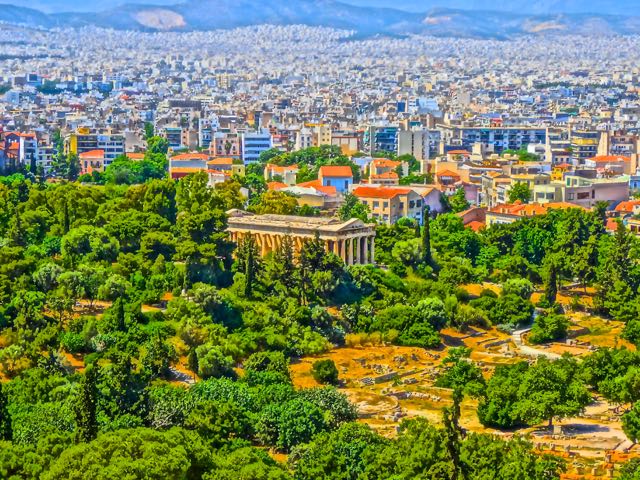 The Ancient Agora, or what is left of it, covers the flatlands and the hill that leads up to the Acropolis. At one time there were houses and shops here but in 1931 the American School of Classical Studies with money from John D. Rockefeller came to the conclusion that under all these homes and businesses there
was probably some major pieces of the Athens archaeological puzzle just waiting to be found, if they could only get rid of all these people. It was not really a wild hunch as there had been excavations by the Greeks and the Germans in the late 19th Century and the building of the train line to Pireaus had exposed lots of ancient buildings and artifacts. Still the American's had to convince the Greek government to allow them to destroy over 400 buildings, many of which, had they been in your town or city would
themselves
be tourist
attractions. But what they exposed was the center of Athenian life, though you need a guide or a guidebook to have any idea of what you are actually looking at. The Ancient Agora, or what is left of it, covers the flatlands and the hill that leads up to the Acropolis. At one time there were houses and shops here but in 1931 the American School of Classical Studies with money from John D. Rockefeller came to the conclusion that under all these homes and businesses there
was probably some major pieces of the Athens archaeological puzzle just waiting to be found, if they could only get rid of all these people. It was not really a wild hunch as there had been excavations by the Greeks and the Germans in the late 19th Century and the building of the train line to Pireaus had exposed lots of ancient buildings and artifacts. Still the American's had to convince the Greek government to allow them to destroy over 400 buildings, many of which, had they been in your town or city would
themselves
be tourist
attractions. But what they exposed was the center of Athenian life, though you need a guide or a guidebook to have any idea of what you are actually looking at.
|
|
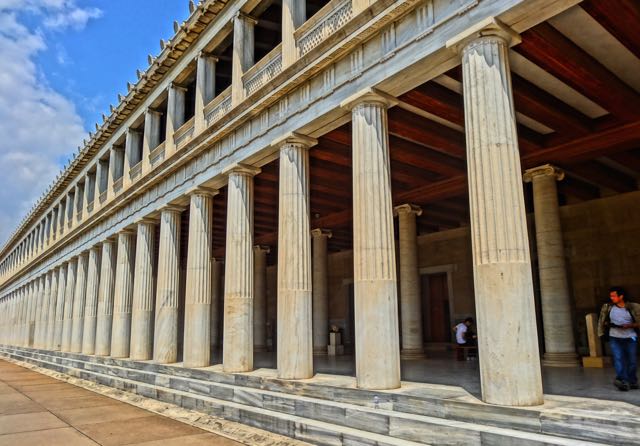 One impressive building that you have probably noticed if you have stood on the Acropolis or sat in one of the restaurants or cafes on lower Adrianou Street, is the long colonnaded 2nd Century BC Stoa of Attalos, though it may dampen your awe to know that this is a reconstruction of the ancient building, completed in 1956 by the
American
School of Classical Studies. You can still see the remnants of the original building and the Stoa of Attalos now serves as a museum for the archaeological site. But regardless of the fact that it is only a half century old, it is still an impressive building with artifacts from the Neolithic to the Post-byzantine and Ottoman periods. The original building was built by King Attalos II of Pergamon, who ruled between 159 BC and 138 BC but it was destroyed in 267 by the Heruli, a Germanic tribe who raided
the Balkans and conquered the ancient cities of Athens, Byzantium and Sparta before settling in Scandinavia, only to return again in the 20th century as tourists. By the way, a stoa is a covered walkway and there are a number of more modern ones scattered around the shopping district of Athens. One impressive building that you have probably noticed if you have stood on the Acropolis or sat in one of the restaurants or cafes on lower Adrianou Street, is the long colonnaded 2nd Century BC Stoa of Attalos, though it may dampen your awe to know that this is a reconstruction of the ancient building, completed in 1956 by the
American
School of Classical Studies. You can still see the remnants of the original building and the Stoa of Attalos now serves as a museum for the archaeological site. But regardless of the fact that it is only a half century old, it is still an impressive building with artifacts from the Neolithic to the Post-byzantine and Ottoman periods. The original building was built by King Attalos II of Pergamon, who ruled between 159 BC and 138 BC but it was destroyed in 267 by the Heruli, a Germanic tribe who raided
the Balkans and conquered the ancient cities of Athens, Byzantium and Sparta before settling in Scandinavia, only to return again in the 20th century as tourists. By the way, a stoa is a covered walkway and there are a number of more modern ones scattered around the shopping district of Athens.
|
|
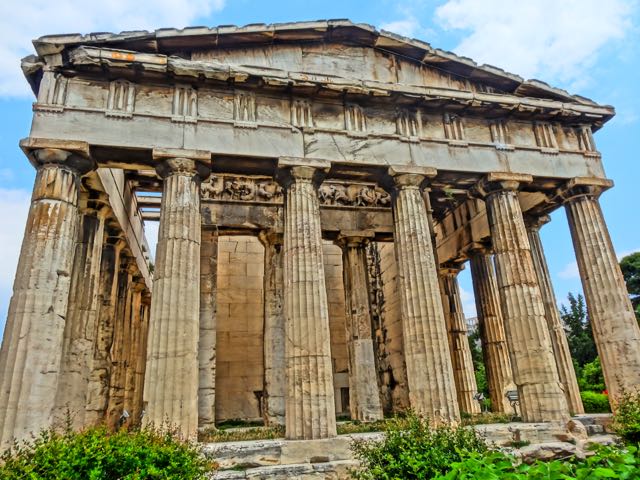 More impressive, due to the fact that it is indeed an ancient building, is the Temple of Haephestus, commissioned by Pericles and completed in 415 BC, two years before the Parthenon and the other massive building projects of Golden Age Athens. The temple sits on the small hill directly across from the Stoa of Attalos
and is one of the most photographed buildings after the Parthenon. That is because this is one of the most intact ancient buildings in existence, mainly because it was converted from a pagan temple to a Christian church. The temple was originally thought to have been dedicated to the mythical King Theseus, founder of Athens though this was later refuted. But not in time to keep the surrounding neighborhood from being named Thission. Haephestus was the God of volcanoes and metal
workers and the remnants of workshops and foundries have been excavated in the area. More impressive, due to the fact that it is indeed an ancient building, is the Temple of Haephestus, commissioned by Pericles and completed in 415 BC, two years before the Parthenon and the other massive building projects of Golden Age Athens. The temple sits on the small hill directly across from the Stoa of Attalos
and is one of the most photographed buildings after the Parthenon. That is because this is one of the most intact ancient buildings in existence, mainly because it was converted from a pagan temple to a Christian church. The temple was originally thought to have been dedicated to the mythical King Theseus, founder of Athens though this was later refuted. But not in time to keep the surrounding neighborhood from being named Thission. Haephestus was the God of volcanoes and metal
workers and the remnants of workshops and foundries have been excavated in the area.
|
|
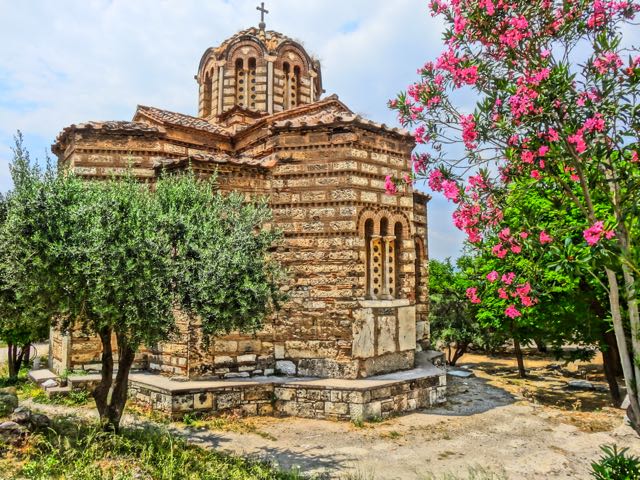 Towards the upper part of the Ancient Agora is the restored Byzantine Church of the Holy Apostles which was built in 1000 AD and along with the Temple of Haephestus is the only building in the Agora to survive intact. Like many Byzantine churches you can see bits and pieces of marble from ancient
buildings and temples that were destroyed by the early Christians because they were pagan. The church was built on the ruins of a 2nd-century Nymphaeum, a monument honoring the nymphs and most likely much of the marble is from that structure which most likely contained a fountain. When the church was restored in the late 19th century they added some extensions but these were removed during the restoration work in the 1950's and the church now looks pretty much as it did originally. There are some
17th
and 18th century wall frescos inside the church though nothing too spectacular. Towards the upper part of the Ancient Agora is the restored Byzantine Church of the Holy Apostles which was built in 1000 AD and along with the Temple of Haephestus is the only building in the Agora to survive intact. Like many Byzantine churches you can see bits and pieces of marble from ancient
buildings and temples that were destroyed by the early Christians because they were pagan. The church was built on the ruins of a 2nd-century Nymphaeum, a monument honoring the nymphs and most likely much of the marble is from that structure which most likely contained a fountain. When the church was restored in the late 19th century they added some extensions but these were removed during the restoration work in the 1950's and the church now looks pretty much as it did originally. There are some
17th
and 18th century wall frescos inside the church though nothing too spectacular.
|
|
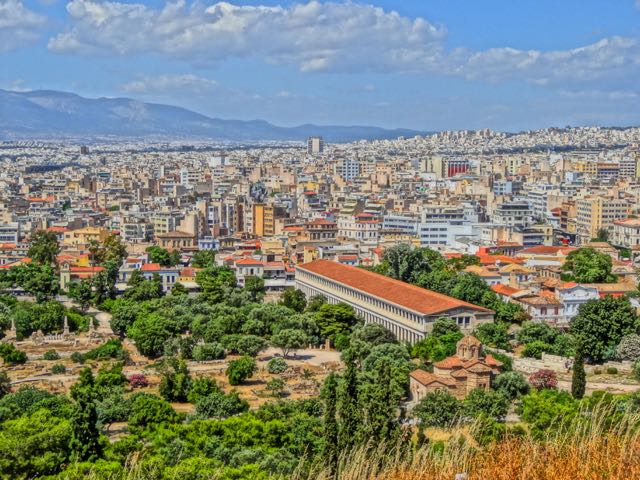 There are a number of monuments and bits and pieces of ancient buildings scattered throughout the area as well as the remnants of ancient streets, and the trees and wildlife make it feel like being in a park. For fans of the movie FOR THE LOVE OF BENJI this is where Benji the dog ran to after stealing
the sausages from the Kypseli Demotiko Agora on Fokionos Negri and shared it with the large Athenian street dog. (Not an easy trip for such a small dog). The Ancient Agora has an entrance just below the Acropolis and another on Adrianou Street in Monastiraki right across from all the restaurants and cafés. The ticket for the site is 4 euros but the 12 euro Acropolis ticket gives you admission to the Ancient Agora as well as the Acropolis, Kerameikos,
the Roman Agora, the Temple of Olympian Zeus, Hadrian's Library and
the corresponding museums for a period of 4 days. Not the Acropolis Museum though. Sorry. The Ancient Agora is open every day from 8 to 8. There are a number of monuments and bits and pieces of ancient buildings scattered throughout the area as well as the remnants of ancient streets, and the trees and wildlife make it feel like being in a park. For fans of the movie FOR THE LOVE OF BENJI this is where Benji the dog ran to after stealing
the sausages from the Kypseli Demotiko Agora on Fokionos Negri and shared it with the large Athenian street dog. (Not an easy trip for such a small dog). The Ancient Agora has an entrance just below the Acropolis and another on Adrianou Street in Monastiraki right across from all the restaurants and cafés. The ticket for the site is 4 euros but the 12 euro Acropolis ticket gives you admission to the Ancient Agora as well as the Acropolis, Kerameikos,
the Roman Agora, the Temple of Olympian Zeus, Hadrian's Library and
the corresponding museums for a period of 4 days. Not the Acropolis Museum though. Sorry. The Ancient Agora is open every day from 8 to 8.
|
The Roman Agora
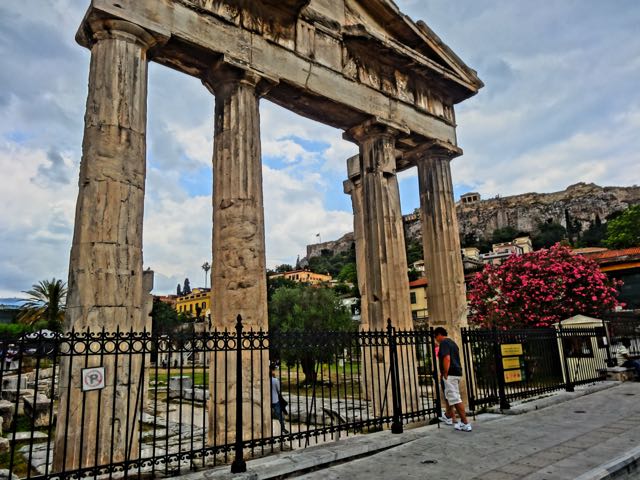 The Roman Agora was built in the 1st century BC during the reigns of Julius Ceasar and Ceasar Augustus with donations from the two emperors. The Gate of Athena Archegetis, was the entrance to the market, a large columned structure that looks like the front of a temple and sits on the western
edge of the archaeological site. Like the Ancient Agora the entire archaeological site was covered with houses and in some old paintings and prints you can see the Gate of Athena rising up from among the buildings. Most of these houses were built in the Byzantine and Turkish periods so again you have a case of tearing down historical buildings to expose older historical buildings, and though it does not cover an area as large as the Ancient Agora you have to wonder how many architectural treasures were lost
in the uncovering of these ruins. These excavations began in 1837 by the Greek Archaeological Society and have continued into the 20th century. The Roman Agora was built in the 1st century BC during the reigns of Julius Ceasar and Ceasar Augustus with donations from the two emperors. The Gate of Athena Archegetis, was the entrance to the market, a large columned structure that looks like the front of a temple and sits on the western
edge of the archaeological site. Like the Ancient Agora the entire archaeological site was covered with houses and in some old paintings and prints you can see the Gate of Athena rising up from among the buildings. Most of these houses were built in the Byzantine and Turkish periods so again you have a case of tearing down historical buildings to expose older historical buildings, and though it does not cover an area as large as the Ancient Agora you have to wonder how many architectural treasures were lost
in the uncovering of these ruins. These excavations began in 1837 by the Greek Archaeological Society and have continued into the 20th century.
|
|
 The Turkish mosque of Fethiye Djami sits on the north side of the Roman Agora. It was built in 1456 AD on the ruins of an Early Christian basilica, converted into a mosque in 1456 to celebrate the visit to Athens by Sultan Mehmed the Conqueror in 1458. During the Venetian occupation
the mosque was converted into a Catholic church dedicated to Dionysius the Areopagite. After the 1821 Greek War of Independence the mosque was used as a school for the Filomousos Eteria, the Society of the Friends of the Muses, an organization of intellectuals and revolutionaries for educating the Greeks and promoting Hellenism during the years of Turkish occupation. The mosque has never been fully restored and has been used mostly as a storage area for the archaeological site though there
are plans
to turn it into some kind of cultural center or museum. In the meantime they have had to remove all the artifacts being stored inside because they are afraid it may fall down before they do. The Turkish mosque of Fethiye Djami sits on the north side of the Roman Agora. It was built in 1456 AD on the ruins of an Early Christian basilica, converted into a mosque in 1456 to celebrate the visit to Athens by Sultan Mehmed the Conqueror in 1458. During the Venetian occupation
the mosque was converted into a Catholic church dedicated to Dionysius the Areopagite. After the 1821 Greek War of Independence the mosque was used as a school for the Filomousos Eteria, the Society of the Friends of the Muses, an organization of intellectuals and revolutionaries for educating the Greeks and promoting Hellenism during the years of Turkish occupation. The mosque has never been fully restored and has been used mostly as a storage area for the archaeological site though there
are plans
to turn it into some kind of cultural center or museum. In the meantime they have had to remove all the artifacts being stored inside because they are afraid it may fall down before they do.
|
|
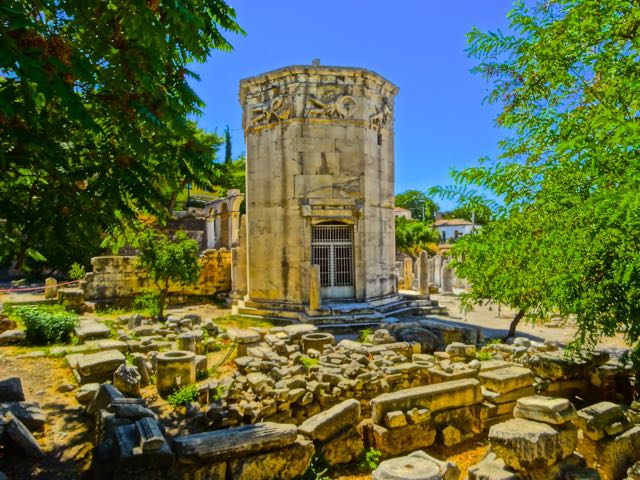 The most famous and most popular building in the Roman Agora is the Tower of the Winds which is an eight-sided marble tower that is a combination water clock, sundial, and a weathervane that was built sometime between the Second and First Century BC by Andronicus of Cyrrhus, a Macedonian astronomer. The top of the
tower has a frieze that portrays
the eight wind directions and at one time there was a colonnaded porch. The tower has been the inspiration for a number of European monuments and is a popular subject for painters. During the Turkish period it was used as a teke, a place for men to hang out, talk and smoke narghiles (water-pipes) and was also used by whirling dervishes, the Sufi group who use dance as meditation. In Stuart & Revett's The Antiquities of Athens from 1762 you can see how the centuries of
building
and destruction raised the street level of the city so that the entrance was practically underground. (Also note the antiquities used in the building of walls). The most famous and most popular building in the Roman Agora is the Tower of the Winds which is an eight-sided marble tower that is a combination water clock, sundial, and a weathervane that was built sometime between the Second and First Century BC by Andronicus of Cyrrhus, a Macedonian astronomer. The top of the
tower has a frieze that portrays
the eight wind directions and at one time there was a colonnaded porch. The tower has been the inspiration for a number of European monuments and is a popular subject for painters. During the Turkish period it was used as a teke, a place for men to hang out, talk and smoke narghiles (water-pipes) and was also used by whirling dervishes, the Sufi group who use dance as meditation. In Stuart & Revett's The Antiquities of Athens from 1762 you can see how the centuries of
building
and destruction raised the street level of the city so that the entrance was practically underground. (Also note the antiquities used in the building of walls).
|
|
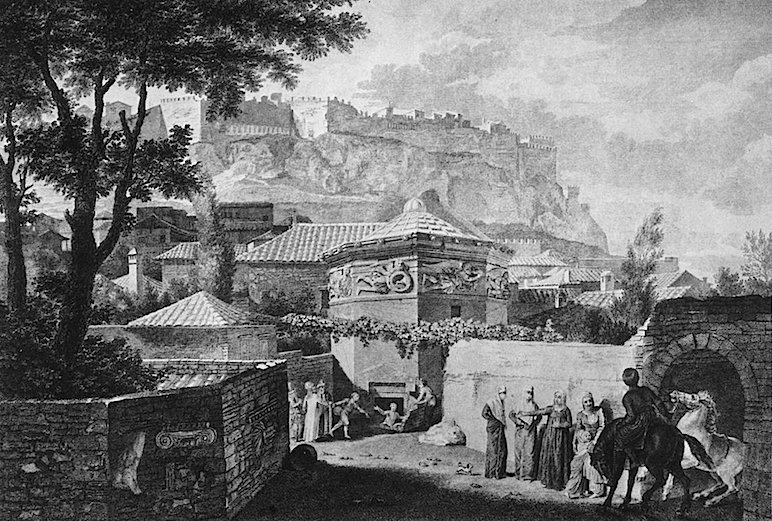
|
|
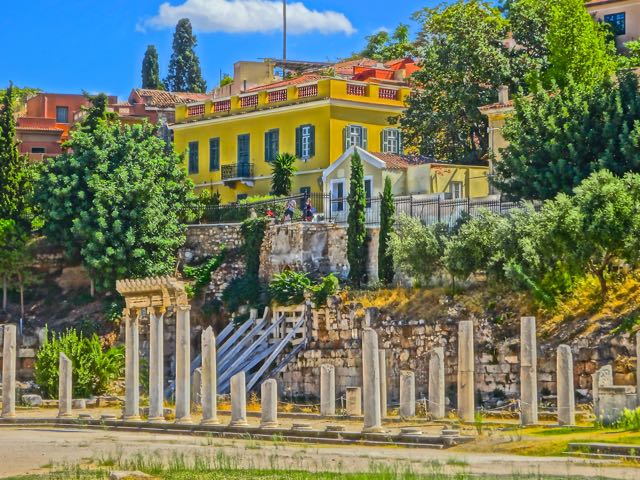 There is also an entrance to the site on this end of the Roman Agora, or an exit if you prefer, that will leave you right on Aeolou Street which takes you to Monastiraki on your left or The Plaka on your right. Right across from the entrance/exit is the Museum of Musical Instruments and a small platia that is the location of the famous Platanos Taverna. If you are wandering around The Plaka waiting for lunch time and you are tired of shopping go check
out the Roman Agora. Even if you don't care about the Romans or archaeology it is good exercise and you can work up an appetite. The ticket is pretty cheap and it is open from 8am to 3pm so if you love Romans and archaeology don't leave this for last since it closes earlier than the other sites. There is also an entrance to the site on this end of the Roman Agora, or an exit if you prefer, that will leave you right on Aeolou Street which takes you to Monastiraki on your left or The Plaka on your right. Right across from the entrance/exit is the Museum of Musical Instruments and a small platia that is the location of the famous Platanos Taverna. If you are wandering around The Plaka waiting for lunch time and you are tired of shopping go check
out the Roman Agora. Even if you don't care about the Romans or archaeology it is good exercise and you can work up an appetite. The ticket is pretty cheap and it is open from 8am to 3pm so if you love Romans and archaeology don't leave this for last since it closes earlier than the other sites.
|
|
|
Help Support Matt's Greece Guides
Do you enjoy using my site? Have you found it entertaining as well as useful? If so please show your appreciation by booking hotels through the travel agencies and the links found on my Hotels of Greece site. The small commission I make on the bookings enable me to keep working and in most cases you won't find them any cheaper by searching elsewhere.
You can find
hotels in Greece by location, price, whether or not it has a swimming pool, and see photos and reviews by using this link to booking.com which also contributes to my website when you book. If you are appreciative of all the free information you get on my websites you can also send
a donation through Paypal or Venmo
Join Matt Barrett's Greece Travel Guides Group on Facebook for comments, photos and other fun stuff. If you enjoy this website please share it with your friends on Facebook and other social media.
|

 The Ancient Agora of Athens is the largely green area in between Monastiraki and the Acropolis, one of the few archaeological sites in the world that has a train running through it. Agora means marketplace and the scattered piles of rocks and foundational walls are what is left of the
stalls, buildings and
shrines that were the center of life in ancient Athens where Socrates, Pericles, Plato and the rest of those guys once walked, talked and bought fistikia and pasetempo. If you are coming from the Acropolis your entrance ticket used to allow you to visit the Ancient Agora which was great because it is a shortcut to
The Ancient Agora of Athens is the largely green area in between Monastiraki and the Acropolis, one of the few archaeological sites in the world that has a train running through it. Agora means marketplace and the scattered piles of rocks and foundational walls are what is left of the
stalls, buildings and
shrines that were the center of life in ancient Athens where Socrates, Pericles, Plato and the rest of those guys once walked, talked and bought fistikia and pasetempo. If you are coming from the Acropolis your entrance ticket used to allow you to visit the Ancient Agora which was great because it is a shortcut to  The Ancient Agora, or what is left of it, covers the flatlands and the hill that leads up to the Acropolis. At one time there were houses and shops here but in 1931 the American School of Classical Studies with money from John D. Rockefeller came to the conclusion that under all these homes and businesses there
was probably some major pieces of the Athens archaeological puzzle just waiting to be found, if they could only get rid of all these people. It was not really a wild hunch as there had been excavations by the Greeks and the Germans in the late 19th Century and the building of the train line to Pireaus had exposed lots of ancient buildings and artifacts. Still the American's had to convince the Greek government to allow them to destroy over 400 buildings, many of which, had they been in your town or city would
themselves
be tourist
attractions. But what they exposed was the center of Athenian life, though you need a guide or a guidebook to have any idea of what you are actually looking at.
The Ancient Agora, or what is left of it, covers the flatlands and the hill that leads up to the Acropolis. At one time there were houses and shops here but in 1931 the American School of Classical Studies with money from John D. Rockefeller came to the conclusion that under all these homes and businesses there
was probably some major pieces of the Athens archaeological puzzle just waiting to be found, if they could only get rid of all these people. It was not really a wild hunch as there had been excavations by the Greeks and the Germans in the late 19th Century and the building of the train line to Pireaus had exposed lots of ancient buildings and artifacts. Still the American's had to convince the Greek government to allow them to destroy over 400 buildings, many of which, had they been in your town or city would
themselves
be tourist
attractions. But what they exposed was the center of Athenian life, though you need a guide or a guidebook to have any idea of what you are actually looking at. One impressive building that you have probably noticed if you have stood on the Acropolis or sat in one of the restaurants or cafes on lower Adrianou Street, is the long colonnaded 2nd Century BC Stoa of Attalos, though it may dampen your awe to know that this is a reconstruction of the ancient building, completed in 1956 by the
American
School of Classical Studies. You can still see the remnants of the original building and the Stoa of Attalos now serves as a museum for the archaeological site. But regardless of the fact that it is only a half century old, it is still an impressive building with artifacts from the Neolithic to the Post-byzantine and Ottoman periods. The original building was built by King Attalos II of Pergamon, who ruled between 159 BC and 138 BC but it was destroyed in 267 by the Heruli, a Germanic tribe who raided
the Balkans and conquered the ancient cities of Athens, Byzantium and Sparta before settling in Scandinavia, only to return again in the 20th century as tourists. By the way, a stoa is a covered walkway and there are a number of more modern ones scattered around the shopping district of Athens.
One impressive building that you have probably noticed if you have stood on the Acropolis or sat in one of the restaurants or cafes on lower Adrianou Street, is the long colonnaded 2nd Century BC Stoa of Attalos, though it may dampen your awe to know that this is a reconstruction of the ancient building, completed in 1956 by the
American
School of Classical Studies. You can still see the remnants of the original building and the Stoa of Attalos now serves as a museum for the archaeological site. But regardless of the fact that it is only a half century old, it is still an impressive building with artifacts from the Neolithic to the Post-byzantine and Ottoman periods. The original building was built by King Attalos II of Pergamon, who ruled between 159 BC and 138 BC but it was destroyed in 267 by the Heruli, a Germanic tribe who raided
the Balkans and conquered the ancient cities of Athens, Byzantium and Sparta before settling in Scandinavia, only to return again in the 20th century as tourists. By the way, a stoa is a covered walkway and there are a number of more modern ones scattered around the shopping district of Athens. More impressive, due to the fact that it is indeed an ancient building, is the Temple of Haephestus, commissioned by Pericles and completed in 415 BC, two years before the Parthenon and the other massive building projects of Golden Age Athens. The temple sits on the small hill directly across from the Stoa of Attalos
and is one of the most photographed buildings after the Parthenon. That is because this is one of the most intact ancient buildings in existence, mainly because it was converted from a pagan temple to a Christian church. The temple was originally thought to have been dedicated to the mythical King Theseus, founder of Athens though this was later refuted. But not in time to keep the surrounding neighborhood from being named Thission. Haephestus was the God of volcanoes and metal
workers and the remnants of workshops and foundries have been excavated in the area.
More impressive, due to the fact that it is indeed an ancient building, is the Temple of Haephestus, commissioned by Pericles and completed in 415 BC, two years before the Parthenon and the other massive building projects of Golden Age Athens. The temple sits on the small hill directly across from the Stoa of Attalos
and is one of the most photographed buildings after the Parthenon. That is because this is one of the most intact ancient buildings in existence, mainly because it was converted from a pagan temple to a Christian church. The temple was originally thought to have been dedicated to the mythical King Theseus, founder of Athens though this was later refuted. But not in time to keep the surrounding neighborhood from being named Thission. Haephestus was the God of volcanoes and metal
workers and the remnants of workshops and foundries have been excavated in the area. Towards the upper part of the Ancient Agora is the restored Byzantine Church of the Holy Apostles which was built in 1000 AD and along with the Temple of Haephestus is the only building in the Agora to survive intact. Like many Byzantine churches you can see bits and pieces of marble from ancient
buildings and temples that were destroyed by the early Christians because they were pagan. The church was built on the ruins of a 2nd-century Nymphaeum, a monument honoring the nymphs and most likely much of the marble is from that structure which most likely contained a fountain. When the church was restored in the late 19th century they added some extensions but these were removed during the restoration work in the 1950's and the church now looks pretty much as it did originally. There are some
17th
and 18th century wall frescos inside the church though nothing too spectacular.
Towards the upper part of the Ancient Agora is the restored Byzantine Church of the Holy Apostles which was built in 1000 AD and along with the Temple of Haephestus is the only building in the Agora to survive intact. Like many Byzantine churches you can see bits and pieces of marble from ancient
buildings and temples that were destroyed by the early Christians because they were pagan. The church was built on the ruins of a 2nd-century Nymphaeum, a monument honoring the nymphs and most likely much of the marble is from that structure which most likely contained a fountain. When the church was restored in the late 19th century they added some extensions but these were removed during the restoration work in the 1950's and the church now looks pretty much as it did originally. There are some
17th
and 18th century wall frescos inside the church though nothing too spectacular. There are a number of monuments and bits and pieces of ancient buildings scattered throughout the area as well as the remnants of ancient streets, and the trees and wildlife make it feel like being in a park. For fans of the movie FOR THE LOVE OF BENJI this is where Benji the dog ran to after stealing
the sausages from the Kypseli Demotiko Agora on Fokionos Negri and shared it with the large Athenian street dog. (Not an easy trip for such a small dog). The Ancient Agora has an entrance just below the Acropolis and another on Adrianou Street in Monastiraki right across from all the restaurants and cafés. The ticket for the site is 4 euros but the 12 euro Acropolis ticket gives you admission to the Ancient Agora as well as the
There are a number of monuments and bits and pieces of ancient buildings scattered throughout the area as well as the remnants of ancient streets, and the trees and wildlife make it feel like being in a park. For fans of the movie FOR THE LOVE OF BENJI this is where Benji the dog ran to after stealing
the sausages from the Kypseli Demotiko Agora on Fokionos Negri and shared it with the large Athenian street dog. (Not an easy trip for such a small dog). The Ancient Agora has an entrance just below the Acropolis and another on Adrianou Street in Monastiraki right across from all the restaurants and cafés. The ticket for the site is 4 euros but the 12 euro Acropolis ticket gives you admission to the Ancient Agora as well as the  The Roman Agora was built in the 1st century BC during the reigns of Julius Ceasar and Ceasar Augustus with donations from the two emperors. The Gate of Athena Archegetis, was the entrance to the market, a large columned structure that looks like the front of a temple and sits on the western
edge of the archaeological site. Like the Ancient Agora the entire archaeological site was covered with houses and in some old paintings and prints you can see the Gate of Athena rising up from among the buildings. Most of these houses were built in the Byzantine and Turkish periods so again you have a case of tearing down historical buildings to expose older historical buildings, and though it does not cover an area as large as the Ancient Agora you have to wonder how many architectural treasures were lost
in the uncovering of these ruins. These excavations began in 1837 by the Greek Archaeological Society and have continued into the 20th century.
The Roman Agora was built in the 1st century BC during the reigns of Julius Ceasar and Ceasar Augustus with donations from the two emperors. The Gate of Athena Archegetis, was the entrance to the market, a large columned structure that looks like the front of a temple and sits on the western
edge of the archaeological site. Like the Ancient Agora the entire archaeological site was covered with houses and in some old paintings and prints you can see the Gate of Athena rising up from among the buildings. Most of these houses were built in the Byzantine and Turkish periods so again you have a case of tearing down historical buildings to expose older historical buildings, and though it does not cover an area as large as the Ancient Agora you have to wonder how many architectural treasures were lost
in the uncovering of these ruins. These excavations began in 1837 by the Greek Archaeological Society and have continued into the 20th century.  The Turkish mosque of Fethiye Djami sits on the north side of the Roman Agora. It was built in 1456 AD on the ruins of an Early Christian basilica, converted into a mosque in 1456 to celebrate the visit to Athens by Sultan Mehmed the Conqueror in 1458. During the Venetian occupation
the mosque was converted into a Catholic church dedicated to Dionysius the Areopagite. After the 1821 Greek War of Independence the mosque was used as a school for the Filomousos Eteria, the Society of the Friends of the Muses, an organization of intellectuals and revolutionaries for educating the Greeks and promoting Hellenism during the years of Turkish occupation. The mosque has never been fully restored and has been used mostly as a storage area for the archaeological site though there
are plans
to turn it into some kind of cultural center or museum. In the meantime they have had to remove all the artifacts being stored inside because they are afraid it may fall down before they do.
The Turkish mosque of Fethiye Djami sits on the north side of the Roman Agora. It was built in 1456 AD on the ruins of an Early Christian basilica, converted into a mosque in 1456 to celebrate the visit to Athens by Sultan Mehmed the Conqueror in 1458. During the Venetian occupation
the mosque was converted into a Catholic church dedicated to Dionysius the Areopagite. After the 1821 Greek War of Independence the mosque was used as a school for the Filomousos Eteria, the Society of the Friends of the Muses, an organization of intellectuals and revolutionaries for educating the Greeks and promoting Hellenism during the years of Turkish occupation. The mosque has never been fully restored and has been used mostly as a storage area for the archaeological site though there
are plans
to turn it into some kind of cultural center or museum. In the meantime they have had to remove all the artifacts being stored inside because they are afraid it may fall down before they do. The most famous and most popular building in the Roman Agora is the Tower of the Winds which is an eight-sided marble tower that is a combination water clock, sundial, and a weathervane that was built sometime between the Second and First Century BC by Andronicus of Cyrrhus, a Macedonian astronomer. The top of the
tower has a frieze that portrays
the eight wind directions and at one time there was a colonnaded porch. The tower has been the inspiration for a number of European monuments and is a popular subject for painters. During the Turkish period it was used as a teke, a place for men to hang out, talk and smoke narghiles (water-pipes) and was also used by whirling dervishes, the Sufi group who use dance as meditation. In Stuart & Revett's The Antiquities of Athens from 1762 you can see how the centuries of
building
and destruction raised the street level of the city so that the entrance was practically underground. (Also note the antiquities used in the building of walls).
The most famous and most popular building in the Roman Agora is the Tower of the Winds which is an eight-sided marble tower that is a combination water clock, sundial, and a weathervane that was built sometime between the Second and First Century BC by Andronicus of Cyrrhus, a Macedonian astronomer. The top of the
tower has a frieze that portrays
the eight wind directions and at one time there was a colonnaded porch. The tower has been the inspiration for a number of European monuments and is a popular subject for painters. During the Turkish period it was used as a teke, a place for men to hang out, talk and smoke narghiles (water-pipes) and was also used by whirling dervishes, the Sufi group who use dance as meditation. In Stuart & Revett's The Antiquities of Athens from 1762 you can see how the centuries of
building
and destruction raised the street level of the city so that the entrance was practically underground. (Also note the antiquities used in the building of walls).
 There is also an entrance to the site on this end of the Roman Agora, or an exit if you prefer, that will leave you right on Aeolou Street which takes you to
There is also an entrance to the site on this end of the Roman Agora, or an exit if you prefer, that will leave you right on Aeolou Street which takes you to 


